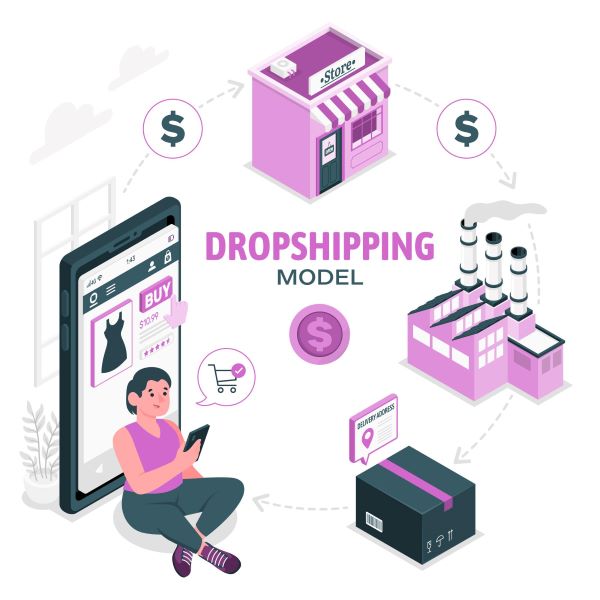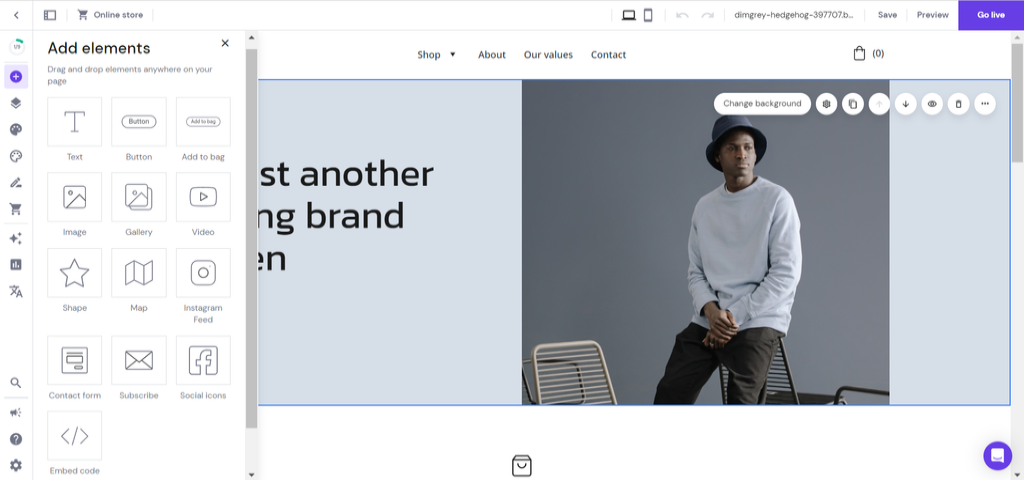One of the simplest methods to generate money online is through dropshipping.
With it, you can purchase goods from a third-party wholesaler or manufacturer and sell them on your eCommerce store as your own. You can concentrate on building your brand and marketing your company because the supplier will handle the logistics and inventories.
If you’re interested, this article will walk you through the process of starting a dropshipping business in seven easy phases, from selecting the ideal niche to developing a brand to setting up an online store and advertising the products.
Dropshipping: what Is It?
Dropshipping is a form of order fulfilment used to sell goods online from suppliers including manufacturers, wholesalers, and retailers.
In this business model, the ‘dropshipper’ or business owner, primarily focuses on marketing and managing the eCommerce store. The supplier manages the items’ inventory and transportation in the interim.
In general, dropshipping operates as follows:
- A customer will pay the retail price for a product from a dropshipper when they make an online purchase.
- The supplier will get the order from the dropshipper. Depending on the terms of the contract, the dropshipper gives the supplier the wholesale price while keeping the profit margin. For instance, the dropshipper will keep the $30 if the buyer pays $100 for a product and the wholesale price is $70.
- Direct shipping of the product to the consumer is done by the supplier after processing the order.

Customers can contact the dropshipper, who will then pass their inquiries to the supplier, if there are problems with product delivery or quality.
Seven steps for starting a dropshipping business
To build a successful dropshipping company, adhere to these seven steps:
- 1: Select a dropshipping industry. Determine the markets to target and the things to sell.
- 2: Locate a drop-ship supplier. Choose a dependable vendor that sells goods in your specialised market.
- 3: Make the brand’s identity. Design a name, logo, and colour scheme for your company that appeals to your target market.
- 4: Create an online shop. Choose between using a website builder or WordPress as the platform for your website and a hosting company.
- 5: Publish the company. To operate your internet store, choose a legitimate business structure and obtain the required licences.
- 6: Organise your finances. Create a company bank account and consider taxes and other costs when setting prices.
- 7: Amplify the online shop. Use SEO, marketing, social media, and other strategies to increase website traffic and sales.
1. Select a dropshipping industry
Dropshipping is used by around 30% of all online retailers, thus there is a lot of rivalry in this market. Making your brand distinctive is essential because other dropshipping websites sell the same products with various branding.
Choosing a niche, which generally refers to a certain consumer segment on which a business should concentrate, is one way to accomplish this.

Here are some pointers for selecting the ideal specialty for an internet business:
- Starting with you. What interests or interests you the most? Finding out what appeals to your audience will be simpler the more you comprehend your specialty.
- Analyse trends. Consider offering high-demand goods all year round to guarantee profitability. For ideas, browse our list of popular products. Finding them is also made easy with the help of programmes like Trendhunter and Google Trends.
After making a list of probable niches, analyse the market and the industry.
By doing this, you can learn about the predictions, chances, and risks that could have an impact on you in the long run. Before the company opens for operation, estimating revenues and developing marketing plans will be simpler.
Consider the following factors:
- Market size and industry value. Find out the size, trends, and growth rate of the market niche. This information reveals whether there are sufficient numbers of clients interested in the goods you want to sell. This approach can be assisted by tools like Semrush.
- Target market. Take into account the demographics of the niche, including the age range, gender, economic level, hobbies, and profession. This knowledge will be useful for the following stage, branding.
- Consumer purchasing patterns. Your pricing and marketing approach are influenced by your knowledge of the factors that influence consumers to buy and how frequently they do so.
- Principal rivals. Find the brands that are leading the industry by using technologies like Similarweb. Consider their advantages and disadvantages, then look for market holes that your company can fill.
2. Locate dropshipping providers
Your dropshipping business’s success may depend on the suppliers you choose to work with. They are in charge of not only producing the goods but also getting them to the customers.
Dropshipping websites like Doba, SaleHoo, AliDropship, and Wholesale2B are the easiest places to find suppliers. Customers can order custom print-on-demand products from some businesses like Printful and Printify.
When looking for suppliers, take into account the following:
- Repute and legality. To avoid con artists, look at the supplier’s client list and request their business licence. To evaluate the company’s level of customer service, read reviews.
- Minimum purchase amount. Verify the supplier’s minimum order requirement for upfront payment. In general, costs decrease when you purchase more products.
- Added charges. In addition to the wholesale price, additional charges could include monthly membership, packaging, refund, and platform fees. Consider each of these while determining the profit margins. After accounting for all of these expenses, a good benchmark is 20-40% or higher.
- Customer support. Verify the supplier’s available customer assistance channels. In the event of customer complaints, make sure they can assist you with any problems and that they can reply quickly.
- Product excellence. Review the item after placing a sample order to ensure that it is of good quality and that the packaging is secure. Comparing comparable products from multiple providers is another smart move.
- Process for completing orders. Take note of how long it takes the provider to complete and deliver the order. Select a supplier who can effectively manage returns as well.
- Integration of a website builder or CMS. A few dropshipping services, such as AliDropship, offer an extension for your website so you can quickly import products from them.
Prepare a dropshipping agreement contract before beginning a business connection with a supplier. This contract details your commercial agreements with them, including the wholesale price of the goods, delivery requirements, damaged products, and more.
3. Develop your company’s brand identity
Along with picking a specialisation, effective branding can help you stand out from the competitors. Your target audience is more likely to recall your branding and make a purchase from you if it is more distinctive.
You can start by using our brand-building guide. Here are the critical actions for a dropshipping business:
- Identify the positioning of your brand. Pick out the major benefit or characteristic that sets you apart from competing brands in the market. In all of your marketing and branding activities, emphasise this aspect.
- Make up a catchy name for your company. Names that are simple to say and type are more likely to be remembered by users. Check out our selection of business name generators if you need assistance.
- Choose a colour scheme that is aesthetically acceptable for your brand’s visual identity. Select hues that go well together, reflect the brand of the company, and appeal to the target market. Consult our website’s colour scheme guide for ideas.
- Select fonts that stand out and are simple to read. Use a distinctive typeface that communicates your brand identity for the logo. For content on websites, graphics for social media, email newsletters, and other communications, choose a more recognisable and readable typeface.
- Create a logo that appears straightforward but attracts attention. People should be able to understand what your company sells and stands for just by looking at it. With Hostinger’s AI logo builder, you can create logos faster.
4. Make an online store
You’ve selected the products you’ll offer, located a supplier, and created a branding plan. Create a website for your company right away.
Although operating a dropshipping business through other online selling platforms is feasible, having your own website has a number of benefits.
One benefit is that you have complete control over your branding and company, from altering the theme to choosing the payment channels. Additionally, you won’t be paying platform fees, which allows you to earn better profit margins than you would on an eCommerce marketplace.
You need to register a domain name in order to build a website. Since most users are familiar with this extension, the majority of businesses will register their company name with a.com ending. At Hostinger, a.com domain costs $9.99/month, but if you have a Premium plan or higher, you can acquire one for free.
If the.com domain you want isn’t available, there are other, less expensive options like.store and.shop that are great for an online store. Both are $0.99 per year.
Next, pick a platform on which to develop the online store.
There are just two options left for individuals with little to no technical knowledge: a website builder or a content management system (CMS).
Let’s investigate what they are, how they differ, and what users each is best suited for. We’ll utilise Hostinger Website Builder and WordPress as examples of a website builder and a CMS, respectively, to make this comparison as straightforward as possible.

Website builder from hostinger
A website builder is a tool created to make the process of creating a website quick and simple for total beginners. It frequently has a drag-and-drop graphic interface that lets users add and rearrange content items directly on their website design.

Benefits of the website builder by hostinger
- Logical AI characteristics. Create a unique website right away using the AI builder mode. In addition, a content generator and a heatmap are available to assist you in creating the content for your website.
- Built-in tools for eCommerce. Up to 500 products can be sold, different payment methods can be enabled, orders can be managed, and the storefront can be tailored to your tastes. No of the plan, all hosting customers get access to these capabilities.
- Included are the necessities. The website builder includes a drag-and-drop editor in addition to a hosting service, designer-made templates, marketing tools, a mobile editing mode, third-party connectors, and more.
Negative aspects of hostinger’s website builder
- Absence of cooperation tools. It is not feasible for numerous individuals to modify the same webpage at once.
- Absence of thoroughness. You cannot install a third-party extension to allow any new features because all the tools are built-in.
Consider purchasing the Business Web Hosting plan if you intend to use the Hostinger Website Builder. It has 200 GB of SSD storage, unlimited bandwidth, and costs $3.99/month, providing more than enough power and room to expand an online business.
WordPress
A content management system is software designed to develop websites, much like a website builder is. The user dashboard is slightly more complicated, which is the difference. That is, several interfaces are typically used to manage different tasks.
For managing pages, writing and publishing material, inserting media, installing themes and plugins, and accessing other settings, for instance, WordPress provides a back-end admin interface.

WordPress enables you to carry out more complicated operations, but it may take some getting accustomed to. For instance, you may set up plugins to provide the CMS new features, such showing customer evaluations from external websites or retrieving abandoned shopping carts.
Benefits of WordPress
- Extensive array of plugins. A simple website may be transformed into a portfolio, an eCommerce business, an online publication, and more with one of the over 60,000 plugins available for WordPress. WooCommerce is a well-known online selling plugin that you’ll need to operate a dropshipping business.
- Large neighbourhood. 43% of websites are powered by WordPress, thus there are a plenty of forums and tools available to assist other users with the software. Check out the WordPress area on Hostinger Tutorials if you need assistance.
- Multi-user capability. You can set up user accounts for your team members and control who has access to the online store if you’re managing a team-based business.
Drawbacks of WordPress
- Learning curve that is steeper. Although learning the basics of coding is not necessary to use WordPress, it may be useful to do so in order to further optimise the website.
- Dependency on plugins. To avoid sluggish performance and security problems, be sure the plugins you install are created and frequently updated by reliable vendors.
Check out our Business WordPress Hosting package to launch a WordPress-powered online store. To make establishing a website easier, it has WordPress-optimized features like a one-click installer, automated software upgrades, and pre-installed plugins and themes.
Additionally, benefit from having access to LiteSpeed caching modules for quick speed and a one-click WordPress staging tool for secure website modifications.
Pay close attention to the following components when developing the online store:
- User encounter. Customers must to be able to easily browse the online store and locate the products they require. For advice and tricks, see our lesson on the finest web design practises.
- Payment processors. Enable a variety of payment methods that your target market uses most frequently. Be open and honest about any taxes and shipping expenses that clients must take into account.
- Product details. To persuade them to purchase a product, create clear and appealing copy for each one.
- Message form. It makes it simple for customers to inquire about your company and its offerings.
- optimisation for mobile. On desktop and mobile screens, the website ought to be simple to use.
5. Prepare the financials for the drop-shipping business
Keeping your personal and corporate finances separate from the beginning is great practise. This will make it much simpler to keep track of the costs and profits associated with your internet business. Additionally, doing so benefits legal procedures.
We advise speaking with a local financial professional to make sure everything is covered because what you should set up will vary depending on your country and location. In general, the following items should be prepared for a dropshipping business:
- Account at a business bank using your dropshipping brand. Use it just for commercial purposes, such as paying suppliers and receiving payments from clients.
- Certificate for resale. In many areas, companies must obtain it in order to sell goods that were manufactured elsewhere. To find out if you have to register and pay for this certificate, contact your local government.
- Income tax. Some nations demand payment from the consumer. Consult the local government of your company and its suppliers regarding the rules governing sales tax nexus. Afterward, factor in this expense when determining the price of the products.
- Fees for maintenance. In order to maintain and expand your business, including platform fees and marketing expenses into your pricing and budgeting.
6. Make your dropshipping business a legal structure by registration
Sorting out the legal aspects of your dropshipping store is a further crucial step. This includes determining whether you require a business licence in your location to dropship. Do thorough study tailored to your nation.
To submit taxes and apply for wholesale dropshipping accounts for businesses in the United States, you will need a sales tax ID and an employer identification number.
Consider creating a lawful business corporation after researching the laws to shield yourself from responsibility. Additionally, doing so may present chances to collaborate with more qualified vendors and business partners.
The three most typical business structures are as follows:
- Single-person business. Your dropshipping business finances will be subject to personal income tax under this structure. This is a dangerous choice because your personal assets are legally linked to your corporation.
- LLC, or limited liability company. You will be protected from personal liability because it creates your company as a distinct legal entity. However, as a business owner, you must adhere to several regulatory criteria when paying taxes.
- Corporation. This choice registers the dropshipping company as a distinct legal entity, much like an LLC. Instead of a small group of business owners, companies are controlled by directors and owned by shareholders.
Create the following web pages in addition to registering your business structure to give your online store a more polished appearance:
- Refund procedures. This page suggests that your dropshipping company is a safe place to make purchases, which helps enhance client trust.
- Policy for returns or exchanges. Since they cannot physically see the object, many clients are hesitant to make an online purchase. They are informed on this page that they are allowed to exchange or return the product if it doesn’t meet their needs.
- Conditions and terms. By having a legal agreement describing your company’s and customers’ rights and duties, you can manage expectations and safeguard your business.
- Privacy statement. This paper demonstrates how seriously your company takes consumer information. Describe its data collection, use, and disclosure practises.
7. Improve and promote your dropshipping company
Your firm is now legitimate because you’ve launched a website. Let’s advertise your goods to attract clients.
You can advertise your dropshipping firm through a variety of digital marketing tools. Look at the following strategies to promote your online store and boost sales:
- SEO, or search engine optimisation. This phrase describes actions taken to increase a website’s position and visibility on search engine results pages (SERPs). You can utilise the integrated SEO tools in Hostinger Website Builder to optimise your website.
- Blogging. Make material that explains to your target market how the products can benefit them. Write how-to articles or listicles that include these things, for example.
- Email promotion. Create an email list by including a subscription form in your shop and rewarding new subscribers with a special offer. Examples of emails to send include alerts on new product releases and price reductions.
- Social media promotion. To reach more potential buyers, promote the products on various social media platforms. Starting out on visual media like Instagram and TikTok is a great idea. One dropshipping company that uses this tactic well is Notebook Therapy.
- Referring business. If you’ve already had a few sales, this tactic will work well. It entails requesting clients to recommend your goods to their friends and family via a referral link. The referee receives a commission, usually between 10% and 20%, for each sale made via the link.
- Affiliate promotion. Similar to the strategy above, but with content creators pushing the products and a typically greater commission rate.
- Marketing for results. Paying for advertising space on websites like Google Ads or Facebook Ads will increase awareness of your company. Although they can be pricey, they also include sophisticated audience targeting settings that make it easier for you to connect with the proper clients.
Why establish a dropshipping business?
When starting a new business, dropshipping is a great option for entrepreneurs. This business model has the following benefits:
- Low startup expenses and low supply chain management. By using dropshipping, there is no longer any need to handle business logistics and make upfront inventory investments. It’s not necessary to produce or store your own goods in order to start selling.
- Business strategy with low risk. Don’t be concerned about production or inventory costs; just add as many things as you can. Dropshippers can quickly substitute a different product for one that is selling poorly if they have one.
- Adaptable place. Since the production process does not require supervision, your business can be operated from any location with an internet connection. Dropshippers must, however, stay in touch with their clients and vendors.
- Greater scaleability. You won’t have to worry as much about receiving additional orders once your company has expanded because the suppliers will manage the shipment.
Having said that, have the following things in mind before beginning a dropshipping enterprise:
- Lower level of control. In order to develop, package, and deliver high-quality products, dropshippers primarily rely on suppliers. You won’t be able to immediately address problems like improper product handling, poor packaging, or delayed delivery.
- Items go out of stock. It’s crucial to follow up with them frequently to avoid advertising unavailable products in your store.
How to start a dropshipping business and what to avoid
Avoid the following when you launch a dropshipping company:
- Picking the incorrect niche. It could be challenging to draw in clients when the market sector is too big or crowded. Finding the ideal niche might be aided by a thorough market analysis.
- Inadequate marketing and branding. Other dropshippers frequently sell the same goods as you do. That is why differentiating yourself from rivals requires a strong brand presence.
- Utilising a hosting service of inferior calibre. Users of the online store will have a positive shopping experience thanks to a quick and secure web host.
- Not adapting your website to the needs of your customers. To increase conversions, test the usability of your website frequently, identify what causes users to leave, and make the necessary adjustments.
- Inadequate customer service. Have a contact form or live chat feature incorporated onto your website so you can talk to clients who need assistance or want to offer feedback on your goods.
- Absence of dialogue with the supplier. Keep in continuous contact with their representative to foresee any shipment or stock concerns.
Conclusion
People with less knowledge and a smaller budget can start an internet business using the dropshipping model because it eliminates the need to manage inventory.
Listed below is a summary of how to start your own online dropshipping business:
- To decide what things to sell, pick a market niche for your business and conduct market research.
- Look for trustworthy and honest dropshipping vendors to supply the products.
- Create a brand for your dropshipping company to distinguish it from rivals.
- Invest in a domain name and build your online business on a simple platform like WordPress or Hostinger Website Builder.
- Create the funds required to safeguard your financial resources, both business and personal.
- Create a legal entity for your dropshipping business.
- To increase traffic and revenue, optimise the online store and sell the products.
We trust that this post has given you more knowledge regarding dropshipping companies and how to launch one.

